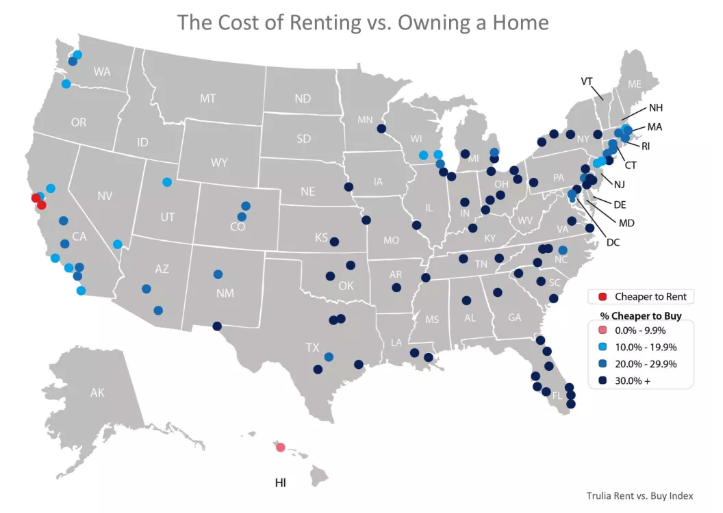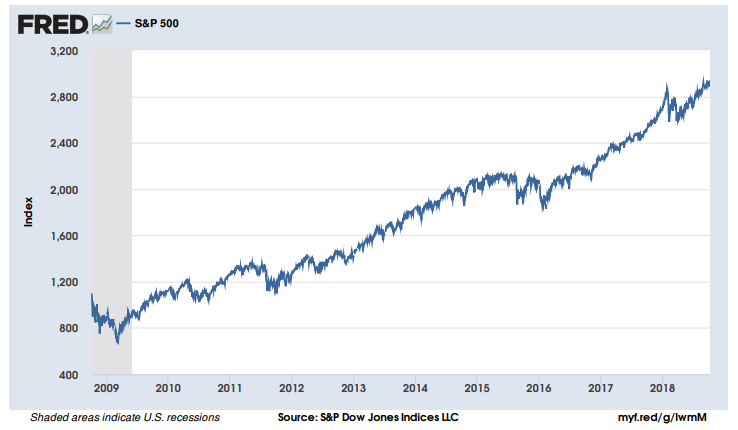In our last article, we looked at some of the causes of the “Great Recession” of 2008 and suggested that there are signs that we could be headed toward a market correction or even a recession based on an over-valued stock market, increasing household and government debt, and rising interest rates.
There are differences between 2018 and 2008, but also some striking similarities.
If you believe this is the case and want to be wise in doing what you can to protect yourself and the resources that God has given you to manage, here are some suggestions for what you might do to minimize your losses should something even remotely resembling 2008 occur again.
You may not want to do any of these things, and I am not saying that you must, but you may want to give them some thought. Most of what I am going to list have to do what you should not do (or should not have done) in recent years as we have seen stock, debt, and real estate “bubbles” show up on the scene again. No doubt some of these things will sound counter-intuitive, but that’s because our intuition is so often wrong because it is overly influenced by assumptions and/or biases that are not valid.
Suggestion #1 – Avoid real estate purchases except for personal use
About a year ago, a friend in my church asked my opinion about buying a vacation home at the beach. I do not own a second home and have no plans to purchase one, but that does not mean that I would never do so. However, in general, and at this particular time, I would be concerned that investment and recreational real estate – especially in popular resort areas – is once again over-valued and may soon be on the way back down.
The graph below shows an index (the S&P/Case-Shiller Home Price Index), which overall has increased dramatically over the last 20 years. The 2008-2009 recession took its toll, but the index is now almost 10% higher than its peak in July of 2006:
Sure, there may be some “deals” out there, but they are few and far between. There is room for some further growth in certain real estate markets, but in my opinion, the next few years is NOT the time to buy investment or recreational real estate unless you are actively in the market and happen on a deal that is too good to pass up. Even then, if you have to mortgage it to the hilt to make the deal, you may want to think twice. Remember how many people found themselves “underwater” during the last recession?
If you are shopping for a home for you or your family, and the real estate market takes a significant dip, that may be a better time to buy. Its also possible that it could rebound quickly afterward, but a recovery may be short-lived, and even better buying opportunities may be available further down the road. If you are in need of a house now and would prefer not to rent, try to find the best deal you can while mortgage rates are still relatively low. Also, as shown in the map below, it is cheaper to buy rather than rent in most areas of the country as housing shortages have driven rents up.
Whether you should consider selling existing investment real estate is a different matter. I am NOT a real estate professional, but I do know when the market falls you will suffer loss if only “on paper.” As in the stock market, its hard to time things perfectly, so holding on indefinitely could be detrimental. But if you do decide to get out of real estate, there are other places to put your money.
You may argue that it makes sense to hold on to rental income property, no matter what. If there is a bubble-burst, will your rental income compensate you for the loss of equity due to the devaluation of your real estate, in inflation-adjusted terms? No matter what, it is essential to consult a tax advisor before selling any real estate, particularly if you anticipate a capital gain.
Suggestion #2: Don’t put a big chunk of “new money” into the stock market
I think there are at least three good reasons for not putting a big lump sum in stocks at this time:
1. Since the Great Recession low in March 2009, the S&P 500 stock index has gained over 300%, taking it nearly 80% higher than its 2007 peak.
Take a look from this chart which shows the performance of the S&P 500 since 2008. It was at approximately 1,000 in 2007 and is now nearly 3,000 – that’s a 300% increase!
It doesn’t take a seasoned professional investor to realize that this kind of sustained market growth is not just uncommon but virtually unheard of. We are now in one of the most extended “bull markets” in history, and some say we are in “bubble” territory based on various measures such as stock-price-to-GDP and price-to-earnings ratios, which can be predictors of things to come.
No one knows where the market will go from here, but most agree that there will be a significant correction simply because there always is. Markets are cyclical. Therefore, they don’t go up forever; they will eventually go down, and sometimes by a lot, so it’s not a question of “if” but “when,” and by how much.
2. Many believe that the US Fed has artificially inflated the stock market with ultra-cheap credit/ultra-low interest rates.
Interest rates have been at historic lows for many years. As shown in this chart, the US Fed Effective Funds Rate has been below 1% since 2008 and has been edging up since 2016:
When interest rates are very low, investors can borrow cheaply to speculate in assets such as cheap mortgages for real estate speculation and trading stocks on margin (borrowed money). This speculative behavior artificially drives up stock prices.
Lower interest rates also make it cheaper for companies to borrow for expansion, buy back shares, increase dividends, and make acquisitions. This may give the allusion of organic business growth when it isn’t.
Low interest rates encourage more borrowing and increased consumption by consumers, which in turn causes households to take on additional debt that can be disastrous when the economy turns soft again. Low mortgage interest rates have helped fuel the sharp rise in housing prices, but many buyers could once again find themselves in trouble if they bought much more house than they should have due to low rates.
3. Another reason that stocks may be in trouble is rising interest rates. When interest rates climb, stock values tend to fall, particularly interest-rate-sensitive businesses.
As I finish this article, the stock market (DJIA) is down almost 6% for the week. That’s because the yield on 10-year Treasury Bonds is up over 3%, the highest its been in about 7 years. Treasury yields go up with rising interest rates and sometimes when investors have less confidence in riskier assets, such as stocks, which have themselves been impacted by increased rates. When that happens, stock prices tend to fall.
Treasuries are also an indicator of where rates may be headed for things like mortgages and auto loans. Higher interest rates tend to slow consumer spending, which also put downward pressure on stocks.
Better to be patient and invest by “dollar-cost-averaging”
Volatility is a given in the stock market – there will always be ups and downs. But now is probably not the time to jump into the market with a large sum of money. Better to buy on the dips, incrementally over time, an approach that is known as “dollar cost averaging.” If you are patient, there may be better buying opportunities down the road.
If you are good at picking individual stocks (few people are), then you may want to look for those that are currently undervalued or that do well during a rising-rate, inflationary time.
If you are a long-term “buy and hold” investor in individual stocks or stock mutual funds, you may be able to ride things out as long as you have a long-term horizon and don’t need to sell in the short-term. The average major market “correction” lasts between 12 and 18 months, so if you can weather the storm, you may be okay in the long run.
Suggestion #3: Avoid long-term bonds and bond funds
As the chart below shows, low interest rates/low bond yields have enabled a corporate borrowing spree in which total outstanding nonfinancial U.S. corporate debt surged $1.7 trillion from its peak in 2008:
The recent borrowing boom caused total outstanding U.S. corporate debt to rise to over 45% of GDP, which is even worse than the level reached during the past several credit cycles. As companies have issues more debt, investors have gobbled it up in the form of individual bonds and bond funds. The problem has been the low yields; consequently, more aggressive “yield-hunting” investors have added more long-term bonds and even “junk” (lower quality) bonds to their portfolio.
In the Fed Fund chart shown previously, we saw that interest rates are finally on the rise. That helps some people, but those holding long-term or “junk” bonds will see the value of their holdings decrease. Why? Because, generally, the longer the maturity of the bond, the more sensitive it is to changes in interest rates. This concept can be difficult to grasp since it seems counter-intuitive, so its best to know that bond duration (or that of bonds held in a mutual fund or ETF) will be affected by interest rate changes.
Another reason is that the longer the duration, the higher the probability that rates will rise sometime during the bond period than for a bond with a shorter period. Therefore, an investor who buys and long-term bond and then wants to sell it early may find that the price has been “discounted.” Discounting is less likely with short-term bonds because there is a lower probability that rates will go up in the short-term. Also, short-term bonds are more likely to be held to maturity, which further reduces the risk.
With rising rates, there’s little reason to invest in long-term bonds or bond funds now. The premium for long-term is far too minimal to be worth the risk.
Suggestion #4: Aggressively pay off debt, especially any adjustable-rate debt
The final chart shows the level of consumer debt that households have taken on since the recession. After a decline from 2008 to 2010, it has been steadily increasing ever since.
Rising interest rates and adjustable-rate loans, credit cards, and mortgages is a toxic mix, especially since so many have been lulled into complacency by low rates for so long. If rates increase dramatically, it could be a disaster for many, similar to what happened before the housing bust in 2008.
My advice is payoff any short-term adjustable rate debt and convert long-term adjustable rate loans to a fixed rate. On the other hand, if you fixed-rate credit card or auto loan debt is not that high, there isn’t a lot of urgency to pay it off other than the fact that it’s better to be debt-free than not. Even very low-balance adjustable-rate credit cards can be held for a while, but don’t wait too long to pay them off.
If you have an investment or personal-use real estate mortgage financed at a variable rate, unload it now, either by selling the real estate or refinancing the loan with a fixed-rate mortgage.
Suggestion #5: If you are in the retirement “red zone,” consider realigning your asset allocation to avoid “sequence of returns risk”
If you are in getting close to retirement or are in the early years of it, you may what to take a look at your asset allocation and adjust it to help mitigate sequence risk. A prolonged downturn in the stock market can really take a toll on retirement savings if the majority of it is invested in stocks. That’s because their value is declining at the very time that you are starting to withdraw from it.
Now might be a good time to consider shifting some assets away from stocks, perhaps into short-term Treasuries or corporate bond funds instead. This will help to preserve some of your capital during a recession.
Consider the next major market “correction” as a buying opportunity
I am not a “gloom- and doom-sayer” guy when it comes to the markets. Over long periods, the market has generally treated investors well. But things can get rough in the short-term. On the other hand, we need to be wise and try to understand the signs where they are right in front of us, which I have tried to depict with the various economic graphs I have included in this article.
The bottom line is this: Based on current market valuations, inflationary pressures, and rising interest rate, I think its a time to be more conservative. There will be market corrections, perhaps several. We could also have another recession. I don’t know when that might happen, nobody does, but I think it could be sooner rather than later. When it does, take advantage of buying opportunities when they come. In the long term, you’ll be glad you did.







